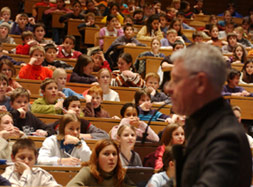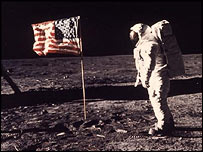[Previous entry: "War and torture"] [Next entry: "Welcome to the real world"]
14/01/2004: "Twin symmetries"
 Exactly a week ago, I wrote on this blog of my twin disappointments of not having been able to see my favourite prof's lecture in front of 500 kids as part of Kinder-Uni, university for kids. I also wrote about my disappointment of learning of Beagle2's near-certain loss, after the failure to communicate with the probe.
Exactly a week ago, I wrote on this blog of my twin disappointments of not having been able to see my favourite prof's lecture in front of 500 kids as part of Kinder-Uni, university for kids. I also wrote about my disappointment of learning of Beagle2's near-certain loss, after the failure to communicate with the probe.
Today, I was allowed a replay of both events, but with a better ending.
First, while I still wasn't allowed in the auditorium to partake of the joy of throwing paper balls around, I watched the performance on screen in an adjacent room. You could still see the paper balls quickly crossing the camera's viewing angle. While I find Kinder-Uni a great idea and encourage such initiatives with no reservation, I believe the lecture itself, while a good effort, was not the imaginative kids-friendly presentation with captivating rhetoric I had expected to hear. Surprisingly dry and dense, I caught myself day-dreaming a couple times during the 45min lecture.
However, the experience for kids is surely going to be a very positive one, if not purely for the lecture. More the chance of experiencing a university environment and being addressed directly about economic issues, a neglected topic for many of them, is bound to have a lasting impact. Cynically, one might call it a sales pitch from the capitalist academia at making future voters and potential students more receptive to the economic worldview. The second event of the day was Bush's speech at NASA. In his words: "Guided by clear objectives, today we set a new course for the American space programme," emphasizing humankind's spirit of discovery and the goal of having a human presence across the solar system, quickly and using existing programmes and personnel. Bush outlined a few key points:
The second event of the day was Bush's speech at NASA. In his words: "Guided by clear objectives, today we set a new course for the American space programme," emphasizing humankind's spirit of discovery and the goal of having a human presence across the solar system, quickly and using existing programmes and personnel. Bush outlined a few key points:
▪ Completing the International Space Station by 2010
▪ Returning the Shuttle to flight asap so as to help finish the ISS
▪ Retiring the Shuttle by 2010
▪ Building a new spacecraft, the Crew Exploration Vehicle, by 2008
▪ Returning to the Moon by 2020, a launching point for missions beyond
▪ (2008 for lunar robotic missions, 2015 manned missions)
▪ Sending humans to Mars and to worlds beyond
Bush: "Human beings are headed into the Cosmos. The crew of Shuttle Columbia did not turn away from the challenge. Neither will we.
While the creation of a committee of private & public sector experts was announced with the objective of reviewiew the above goals (Pete Aldrich, chairman), and while Bush invited nations to join the US in a spirit of cooperation in this journey and not a race, the role of the private sector was not mentioned explicitly. In the article Moon-hopping to Mars in The Economist, these words:
"Ultimately, if NASA is to succeed in human space exploration, it will have to grow its budget substantially, abandon much of its other, valuable work, or ideally find a way of successfully exploiting space commercially. Until now, NASA has been spectacularly unsuccessful in this ambition because it is not designed for this purpose. Any presidential vision ought, then, to include a way of eventually wrestling space activities out of the agency’s clutches and into the hands of the private sector."


